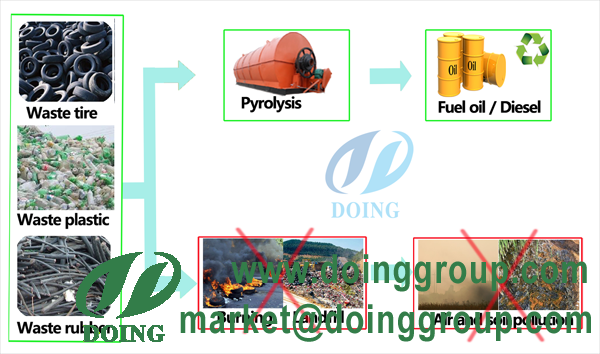Different Types of Waste Disposal
Industry News / Chat online / Give me a price / November 25, 2014
One of the world's most pressing problems is waste disposal. Every country on earth seems to have difficulty dealing with their municipal solid waste. At an individual level, this problem affects people everywhere, for everyone contributes their share of waste that ends up in landfills, incinerators, waste-to-energy plants or the recycling bin. Each homeowner has several options in disposing of waste. They range from simply throwing waste in the garbage to recycling to turning that waste into energy. The following 5 waste disposal systems are available to just about anyone given the right tools and space.
1. Simply Throwing Garbage away
As common as throwing garbage away is, it is also highly problematic when it is taken as a whole. The U.S. commonly throws away 250 million tons or more of garbage annually, consuming more than 3,500 acres of land in the process. There is something very passive about throwing garbage away: put it in the basket and watch the truck haul it away. It is the 'don't ask, don't tell' solution to waste disposal.

The best method to disposal waste tyres
2. Garbage Disposal Installation
Having a home garbage disposal reduces landfill waste by pulverizing food waste and washing it down the drain. The food waste does not become liquid, but it is altered enough not to ruin sewer pipes. A garbage disposal is a step in the right direction, but it solves less than half of the problem. Plenty of waste gets thrown away even with a disposal. Not only that, but the material that can be put down a garbage disposal would be better used in a compost pile.
3. Recycling
Instead of simply throwing everything away in trash, get in the habit of recycling what can be reused or remade. Metal, paper products, certain plastics, motor oil, electronics, appliances, mattresses, wood, rubber, glass and other things can all be recycled. In some cases you have to pay to have it hauled away. Other things people will gladly remove from your recycling pile on the street. If everything that could be recycled was recycled across the board, the aggregate trash amount would be drastically reduced every year.
4. Composting
Taking all of your organic food scraps, including coffee grounds and eggshells (excluding meat, bones, skin and lard) and throwing it in layers on a compost pile eventually breaks it down and becomes nutrient-rich fertilizer. You must keep the amounts in proportion and add grass clippings and other yard debris as well, but when done right you are helping to complete the cycle of life. This is one of the best ways to dispose of (food) waste.
5. Incineration
While this method is mainly used at the industrial level, residential incinerators are available to dispose of waste. There is the danger of releasing toxins from certain materials, though, so be sure you know the potential hazards.
Rather than throwing everything away to go to the landfill, take the time to consider other waste disposal methods. In doing so, you'll cut down on the amount of trash you make, and with composting you may end up with something usable because of it.
1. Simply Throwing Garbage away
As common as throwing garbage away is, it is also highly problematic when it is taken as a whole. The U.S. commonly throws away 250 million tons or more of garbage annually, consuming more than 3,500 acres of land in the process. There is something very passive about throwing garbage away: put it in the basket and watch the truck haul it away. It is the 'don't ask, don't tell' solution to waste disposal.

The best method to disposal waste tyres
2. Garbage Disposal Installation
Having a home garbage disposal reduces landfill waste by pulverizing food waste and washing it down the drain. The food waste does not become liquid, but it is altered enough not to ruin sewer pipes. A garbage disposal is a step in the right direction, but it solves less than half of the problem. Plenty of waste gets thrown away even with a disposal. Not only that, but the material that can be put down a garbage disposal would be better used in a compost pile.
3. Recycling
Instead of simply throwing everything away in trash, get in the habit of recycling what can be reused or remade. Metal, paper products, certain plastics, motor oil, electronics, appliances, mattresses, wood, rubber, glass and other things can all be recycled. In some cases you have to pay to have it hauled away. Other things people will gladly remove from your recycling pile on the street. If everything that could be recycled was recycled across the board, the aggregate trash amount would be drastically reduced every year.
4. Composting
Taking all of your organic food scraps, including coffee grounds and eggshells (excluding meat, bones, skin and lard) and throwing it in layers on a compost pile eventually breaks it down and becomes nutrient-rich fertilizer. You must keep the amounts in proportion and add grass clippings and other yard debris as well, but when done right you are helping to complete the cycle of life. This is one of the best ways to dispose of (food) waste.
5. Incineration
While this method is mainly used at the industrial level, residential incinerators are available to dispose of waste. There is the danger of releasing toxins from certain materials, though, so be sure you know the potential hazards.
Rather than throwing everything away to go to the landfill, take the time to consider other waste disposal methods. In doing so, you'll cut down on the amount of trash you make, and with composting you may end up with something usable because of it.



